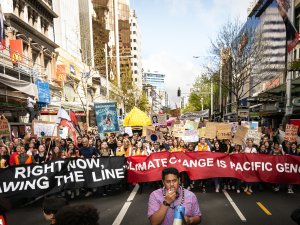Respiratory physician Lutz Beckert considers chronic obstructive pulmonary disease management, including the prevention of COPD, the importance of smoking cessation and pulmonary rehabilitation, and the lifesaving potential of addressing treatable traits. He also discusses the logic of inhaler therapy, moving from single therapy to dual and triple therapy when indicated, as well as other aspects of management
The future is now, the battle is on
The future is now, the battle is on

In a series of articles for the 11 May issue, journalist Virginia McMillan talks to people hoping to change ways of working in health so as to ultimately improve the health of our planet
The current model we have of expanding dairy farming through irrigation is untenable
Floods in coastal towns, fires in wetlands and ice loss in glaciers have all this year underscored the real and present dangers of a warmer globe.
The Intergovernmental Panel on Climate Change is urging rapid, drastic changes to most aspects of modern life to reverse the ongoing rise in emissions of greenhouse gases.
At last count, global emissions rose 1.3 per cent a year, every year between 2000 and 2019.
In recent months, the panel has catalogued worse-than-expected impacts that are on their way as a result of “baked in” climate change.
The panel has also described how to stave off some impacts, change agriculture and horticulture from depleters of soil health to soil builders, restore many of the planet’s natural spaces, make cities more liveable, and remove and store some residual carbon dioxide. All will be needed in pursuit of carbon zero.
At carbon zero, the global temperature will stabilise.
Ora Taiao – New Zealand Climate & Health Council co-convenor and specialist GP Dermot Coffey says extreme weather is, meanwhile, becoming more frequent and severe; land and jobs will be lost and agriculture as we know it won’t be possible in many areas.
The Government later this month will release its emissions reductions plan. Last month, a better view emerged, in the Draft National Adaptation Plan, of New Zealand State agencies’ strategies for adapting the country to climate change.
- Reform of the Resource Management Act 1991 will include tools to stop increasing exposure in areas of high or increasing climate risks, and facilitate the retreat of communities, homes and infrastructure where risks are intolerable.
- A Natural and Built Environments Act, Strategic Planning Act and Climate Change Adaptation Act are planned, the latter to guide retreat management and adaptation funding.
- The National Climate Change Risk Assessment last year said risk to potable water is the most urgent risk from climate change. (The “three waters” regional reform aims to address this.)
- The Ministry for the Environment is working towards supporting iwi/ Māori to develop climate strategies and action plans.
- Work is under way on updating emergency management legislation and guidance.
Source: Draft National Adaptation Plan – Ministry for the Environment
How, in detail, the new health system will manage the sector’s road to zero carbon is not clear.
Ora Taiao and a large cluster of health organisations became frustrated at the limited communication they have been getting about how the new health system will advise, direct and incentivise health providers to “decarbonise”.
Twelve health bodies fired off to media and health minister Andrew Little an open letter calling, among other things, for:
- resourcing for the Māori Health Authority to play a central role in the sector’s response to climate change
- placing te ao Māori at the heart of the response
- incorporating primary care into the response
- all medicine and equipment procurement decisions to have greenhouse gas emissions as a key decision factor
- an immediate stop to international business-class flights for staff, and
- plant-based hospital catering.
Mr Little’s reply points to the Carbon Neutral Government Programme.
This “will join businesses and communities already leading the way to reduce their emissions as we transition to a low-emissions economy”, he says in a letter to the signatories.
Any “laggards” in the private health sector will have to lift their game too, says Mr Little. He reports that the new agencies arising from the health reforms are making progress on climate action.
He has previously said sustainability must be part of every decision.
The letter called for the Government to commit to a dedicated sustainability unit at the heart of the health sector.
Dr Coffey, an NZMA board member, says the unit must provide guidance, direction and incentives for health providers to become low-carbon organisations. (For official guidance under development, see opposite page.)
Beyond the health sector, Dr Coffey says the Government should be targeting much deeper reductions in overall emissions than it has so far, and doing more to incentivise change in agriculture, the country’s largest emitter of greenhouse gases.
“The current model we have of expanding dairy farming through irrigation is untenable even now and will become even more so.”
It’s time the Government supported farmers to regenerate land and aim to lead the world as producers of climate and planet-friendly foods, he says.
The NZMA, a signatory to the open letter, earlier in the year emphasised its view of health as encompassing the health of the planet.
In a position statement, Planetary Health, the association says health gains, health equity and the health of future generations are threatened by unprecedented degradation of natural systems. Much of this degradation is attributed to the global economic system being premised on infinite growth.
Ihirangi, the National Iwi Chairs Forum-supported climate lead, rejects the infinite growth mindset. In a recent report, Ihirangi writes of restoring environmental balance and “relocalising” economic activity.
“Communities need to be empowered to design and deliver their own climate solutions.”
An indigenous framework does not elevate humankind above the environment, says the report, released alongside the draft adaptation plan.
The RNZCGP, which also signed the letter to Mr Little, has reported on its carbon emissions, saying COVID-19 restrictions helped it to make a large decrease for the year 2020/21 compared with the previous year.
The annual report says the college reduced the number of face-to-face meetings it held, as one way of helping to reduce emissions.
Asked about “low carbon” education for trainee GPs, RNZCGP chief executive Lynne Hayman says these issues aren’t covered in a particular course. Managing resources and environmental health outcomes are threaded through the training, Mrs Hayman says.
Decarbonisation isn’t part of general practice standards, either. In the Cornerstone programme for practices, development of new modules is temporarily delayed while the pandemic’s pressures continue.
President Samantha Murton says all aspects of general practice business contain opportunities for lowering the carbon footprint, from e-prescribing to telehealth. The college promotes these opportunities to members, Dr Murton says.
Back in November 2016, the college published its Climate change, health and general practice in Aotearoa New Zealand and the Pacific position statement.
It warned of sea-level rise and coastal erosion, increases in infectious diseases and economic pressures, with the risk these difficulties will be experienced inequitably.
The statement is being reviewed and updated, and an update for the college’s Greening General Practice guide will follow.
- Agriculture and energy were the two largest contributors to New Zealand’s gross emissions of greenhouse gases in 2020, at 50 per cent and 40 per cent respectively.
- Gross emissions at 2020 were 21 per cent higher than in 1990, mainly due to:
• methane – more dairy cattle
• carbon dioxide – transport, manufacturing and construction, and
• nitrous oxide – greater use of fertilisers.
- Net emissions have increased since 1990 by 26 per cent. Source: NZ Greenhouse Gas Inventory 1990–2020
We're publishing this article as a FREE READ so it is FREE to read and EASY to share more widely. Please support us and the hard work of our journalists by clicking here and subscribing to our publication and website








![Barbara Fountain, editor of New Zealand Doctor Rata Aotearoa, and Paul Hutchison, GP and senior medical clinician at Tāmaki Health [Image: Simon Maude]](/sites/default/files/styles/thumbnail_cropped_100/public/2025-03/Barbara%20Fountain%2C%20editor%20of%20New%20Zealand%20Doctor%20Rata%20Aotearoa%2C%20and%20Paul%20Hutchison%2C%20GP%20and%20senior%20medical%20clinician%20at%20T%C4%81maki%20Health%20CR%20Simon%20Maude.jpg?itok=-HbQ1EYA)
![Lori Peters, NP and advanced health improvement practitioner at Mahitahi Hauora, and Jasper Nacilla, NP at The Terrace Medical Centre in Wellington [Image: Simon Maude]](/sites/default/files/styles/thumbnail_cropped_100/public/2025-03/2.%20Lori%20Peters%2C%20NP%20and%20advanced%20HIP%20at%20Mahitahi%20Hauora%2C%20and%20Jasper%20Nacilla%2C%20NP%20at%20The%20Terrace%20Medical%20Centre%20in%20Wellington%20CR%20Simon%20Maude.jpg?itok=sUfbsSF1)
![Ministry of Social Development health and disability coordinator Liz Williams, regional health advisors Mary Mojel and Larah Takarangi, and health and disability coordinators Rebecca Staunton and Myint Than Htut [Image: Simon Maude]](/sites/default/files/styles/thumbnail_cropped_100/public/2025-03/3.%20Ministry%20of%20Social%20Development%27s%20Liz%20Williams%2C%20Mary%20Mojel%2C%20Larah%20Takarangi%2C%20Rebecca%20Staunton%20and%20Myint%20Than%20Htut%20CR%20Simon%20Maude.jpg?itok=9ceOujzC)
![Locum GP Helen Fisher, with Te Kuiti Medical Centre NP Bridget Woodney [Image: Simon Maude]](/sites/default/files/styles/thumbnail_cropped_100/public/2025-03/4.%20Locum%20GP%20Helen%20Fisher%2C%20with%20Te%20Kuiti%20Medical%20Centre%20NP%20Bridget%20Woodney%20CR%20Simon%20Maude.jpg?itok=TJeODetm)
![Ruby Faulkner, GPEP2, with David Small, GPEP3 from The Doctors Greenmeadows in Napier [Image: Simon Maude]](/sites/default/files/styles/thumbnail_cropped_100/public/2025-03/5.%20Ruby%20Faulkner%2C%20GPEP2%2C%20with%20David%20Small%2C%20GPEP3%20from%20The%20Doctors%20Greenmeadows%20in%20Napier%20CR%20Simon%20Maude.jpg?itok=B0u4wsIs)
![Rochelle Langton and Libby Thomas, marketing advisors at the Medical Protection Society [Image: Simon Maude]](/sites/default/files/styles/thumbnail_cropped_100/public/2025-03/6.%20Rochelle%20Langton%20and%20Libby%20Thomas%2C%20marketing%20advisors%20at%20the%20Medical%20Protection%20Society%20CR%20Simon%20Maude.jpg?itok=r52_Cf74)
![Specialist GP Lucy Gibberd, medical advisor at MPS, and Zara Bolam, urgent-care specialist at The Nest Health Centre in Inglewood [Image: Simon Maude]](/sites/default/files/styles/thumbnail_cropped_100/public/2025-03/7.%20Specialist%20GP%20Lucy%20Gibberd%2C%20medical%20advisor%20at%20MPS%2C%20and%20Zara%20Bolam%2C%20urgent-care%20specialist%20at%20The%20Nest%20Health%20Centre%20in%20Inglewood%20CR%20Simon%20Maude.jpg?itok=z8eVoBU3)
![Olivia Blackmore and Trudee Sharp, NPs at Gore Health Centre, and Gaylene Hastie, NP at Queenstown Medical Centre [Image: Simon Maude]](/sites/default/files/styles/thumbnail_cropped_100/public/2025-03/8.%20Olivia%20Blackmore%20and%20Trudee%20Sharp%2C%20NPs%20at%20Gore%20Health%20Centre%2C%20and%20Gaylene%20Hastie%2C%20NP%20at%20Queenstown%20Medical%20Centre%20CR%20Simon%20Maude.jpg?itok=Z6u9d0XH)
![Mary Toloa, specialist GP at Porirua and Union Community Health Service in Wellington, Mara Coler, clinical pharmacist at Tū Ora Compass Health, and Bhavna Mistry, specialist GP at Porirua and Union Community Health Service [Image: Simon Maude]](/sites/default/files/styles/thumbnail_cropped_100/public/2025-03/9.%20Mary%20Toloa%2C%20Porirua%20and%20Union%20Community%20Health%20Service%20in%20Wellington%2C%20Mara%20Coler%2C%20T%C5%AB%20Ora%20Compass%20Health%2C%20and%20Bhavna%20Mistry%2C%20PUCHS%20CR%20Simon%20Maude.jpg?itok=kpChr0cc)